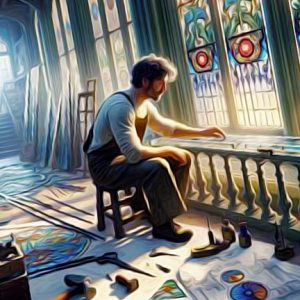 In her second article, Zoe Martin dives deeper into the world of glass restoration, centring on Liam O’Connor, a glazier whose life’s work was to breathe new life into old glass. As Zoe spent more time observing Liam, she became increasingly captivated by the precision and artistry that defined his craft.
In her second article, Zoe Martin dives deeper into the world of glass restoration, centring on Liam O’Connor, a glazier whose life’s work was to breathe new life into old glass. As Zoe spent more time observing Liam, she became increasingly captivated by the precision and artistry that defined his craft.
The article begins with Zoe describing the early morning light filtering through the stained glass windows of the community building, casting colourful patterns on the stone floor. It was in this mesmerising ambience that Liam, known as the best Melbourne glazier, worked, his hands moving with a rhythm honed by years of experience. The restoration project was not just about repairing; it was about honouring the original craftsmanship that went into creating these intricate glass balustrades.
Zoe outlines the painstaking process that Liam follows. Each piece of glass is carefully removed, cleaned, and assessed for damage. Liam then uses a combination of traditional techniques and modern technology to repair or recreate pieces that are beyond repair. His workshop, a treasure trove of glass pieces, tools, and sketches, reflects a dedication that goes beyond mere work.
Throughout the article, Zoe infuses anecdotes from Liam’s life, painting a picture of a man who sees his job as a calling. Liam shares stories of his apprenticeship with a renowned glazier, his travels to study ancient glasswork in Europe, and his return to Melbourne, where he found a purpose in preserving the city’s architectural heritage.
Zoe also sheds light on the broader significance of Liam’s work. By providing glass balustrade repair services close to Melbourne, Liam is not just fixing old structures; he’s keeping a part of the city’s history alive. His work ensures that future generations will continue to enjoy and appreciate these architectural masterpieces.
The article delves into the technical aspects of glass repair, educating readers on the different types of glass used in balustrades, the challenges in colour matching, and the techniques used to ensure structural integrity. Zoe’s narrative skillfully bridges the gap between technical jargon and layman’s understanding, making the subject accessible and interesting.
Zoe concludes the article with a reflective tone. Watching Liam work, she contemplates the transient nature of many modern creations and the enduring beauty of those built with time, patience, and skill. In Liam’s work, she sees a metaphor for the city itself – constantly evolving yet rooted in a rich, colourful history.